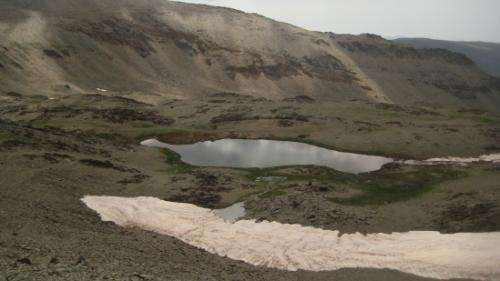Lake found in Sierra Nevada with the oldest remains of atmospheric contamination in southern Europe

Atmospheric contamination due to heavy metals is currently a severe problem of global proportions, with important repercussions in public health. However, this type of pollution is not a recent fact and can even be detected during pre-historic times.
A team of scientists, which includes scientists from the Andalusian Institute of Earth Sciences and the University of Granada, has discovered evidence of atmospheric pollution caused by lead. This evidence was found in a lagoon in Sierra Nevada (Granada), at an altitude of 3,020 m. The pollution comes from metallurgical activities, carried out some 3,900 years ago (Early Bronze Age). This find refers to the oldest atmospheric pollution on record in southern Europe.
The study, published in the journal, Science of the Total Environment, was carried out by researchers from the Andalusian Institute of Earth Sciences (Spain), the University of Granada (Spain), the University of Sevilla (Spain), the University of North Arizona (USA), the Andalusian Regional Government (Spain) and the Granada firm Estudios Geológicos y Medioambientales S.L. (Spain). The main author of this research is Antonio Garcia-Alix, from the Andalusian Institute of Earth Sciences.
Influence of man on the environment
The article reveals the influence of human activity on the environment due to the beginnings of metallurgy at the end of the Holocene period in southern Europe. From the geochemical analyses carried out on the sediments deposited during the past 10,000 years in the Laguna de Rio Seco lagoon, a remote alpine lake in Sierra Nevada, at 3,020 m. above sea level, evidence has been found of atmospheric pollution from lead. This contamination is traced back to metallurgical activities from 3,900 years ago (Early Bronze Age), coinciding with an increase in forest fires and deforestation in southern Europe.
As the University of Granada researcher, Jose Antonio Lozano Rodriguez explains, "this data tells us of the great influence our ancestors had on the environment. Lead pollution gradually increased during the Late Bronze Age and the Early Iron Age, coinciding with the development and expansion of metallurgy in southern Europe". The samples studied show a maximum contamination from lead about 2,900 years ago, which would imply an intense movement and manipulation of this metal in the area around Sierra Nevada.
Contamination during the Roman Empire
In the samples studied by the scientists, there are also high levels of atmospheric contamination from lead during the Roman Empire, when large quantities of this metal were extracted in the south of the Iberian Peninsula, as well as during the past 300 years, coinciding with the Industrial Revolution and the reactivation of mining activity in southern Spain.
A curious detail also shown by the study is a reduction in atmospheric pollution from lead during the last few decades, which, as Lozano concludes, "suggests that the global measures taken to reduce lead emissions, such as the use of lead-free gasoline, have helped to reduce the levels of this metal in the atmosphere".
More information: Garcia-Alix, A. et al. (2013), Anthropogenic Impact and Lead Pollution Throughout the Holocene in Southern Iberia. Science of the Total Environment, 449: 451-460. DOI:10.1016/j.scitotenv.2013.01.081.
Journal information: Science of the Total Environment
Provided by University of Granada

















